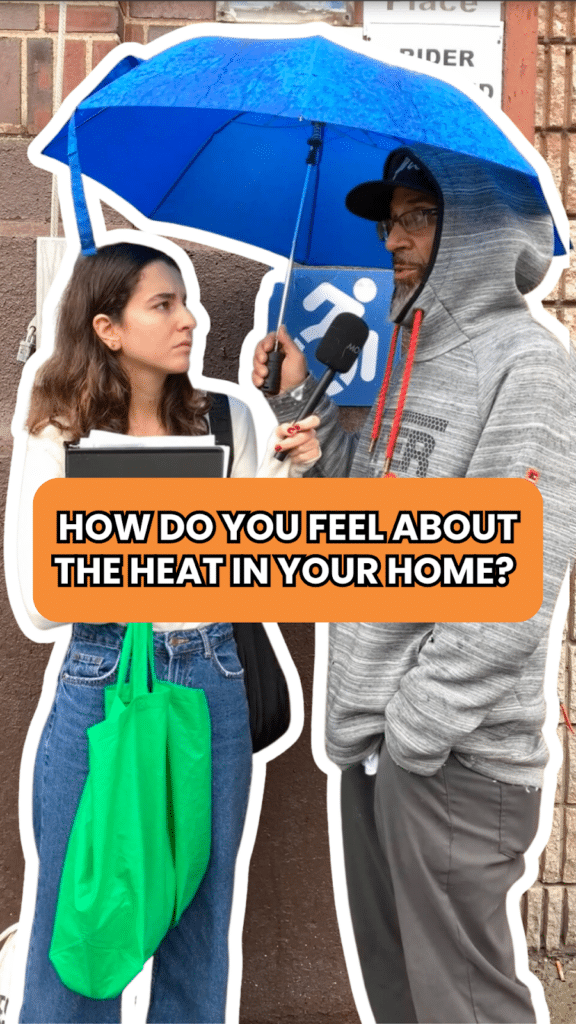
By Shane Araujo
Shane Araujo is a research assistant and the junior editor for the Hot & Cold NYC team at the Energy, Equity, Housing, and Health program (E2H2 at Columbia University Mailman School of Public Health) led by Dr. Diana Hernández. In this blog, Shane discusses the importance of social media as a critical tool for uplifting marginalized voices, particularly those who experience energy insecurity in New York City.
What is energy insecurity? Simply put, energy insecurity is defined as the inability to meet your household energy needs. In her seminal article on this topic, Dr. Diana Hernández explained that energy insecurity is a “multi-dimensional construct that describes the interplay between physical conditions of housing, household energy expenditures and energy-related coping strategies.”
The work of Dr. Hernández has shown that low-income neighborhoods, particularly Black and Brown communities, are more likely to experience energy insecurity. In New York City, low-income neighborhoods, such as the South Bronx have high rates of energy insecurity due to redlining and subsequent infrastructural neglect. This can manifest in various forms including the inability to pay utility bills, reliance on unsafe or inefficient energy sources, and lack of access to modern energy services such as electricity and clean cooking facilities.
The most paradoxical aspect of this phenomenon is that people with lower incomes living in outdated or “pre-war” buildings may be paying higher energy bills compared to folks living in modern, well-maintained buildings. These outdated buildings often lack proper insulation and maintenance, leading to increased difficulties regulating the indoor temperature due to drafts and faulty heating/cooling systems.
While there is a growing body of research on energy insecurity, it is still a widely unknown concept to the public. Given that scholarly literature is often inaccessible and energy insecurity is an understudied phenomenon, creating accessible information for the public may allow people to identify ways in which they experience energy insecurity and learn about solutions.

This is where our social media presence seeks to have an impact. In 2023, the E2H2 team launched @hotandcold_NYC on Instagram, TikTok, and YouTube as a research translation and dissemination platform that features people-centered content related to energy insecurity and the just energy transition. This university-based, student-led initiative, seeks to showcase “faces and places of energy insecurity” and raise awareness about this inconspicuous phenomenon.

Our team designs engaging infographics about energy insecurity and energy justice, produces short videos that highlight stories of the experiences and ingenuity of NYC residents, raises awareness about federal assistance programs like the Low Income Home Energy Assistance Program (LiHEAP), and connects individuals with resources that may alleviate the burdens produced by this widespread phenomenon.
We aim to leverage our social media content as a source for policymakers and city officials to better understand the issue at hand and inspire them to take action. Our hope is to be a catalyst for enacting policy and practice-based changes that benefit these households and communities.
“I’ve written dozens of academic and policy-oriented papers, many of them may have never been read,” said Dr. Hernández. Explaining the motivation behind @hotandcold_nyc, she noted, “we created this platform to share the perspectives of people and an experience that is often hidden behind closed doors. Our grid sheds light on this important issue with the hopes of connecting on a human level.”
The personal anecdotes we collect and share on our social media platforms are intended to humanize the voices behind the research, and remind everyone, particularly those creating policy, that there are real people suffering in the privacy of their homes because of energy insecurity. The level of nuance and ability to hear directly from those with lived expertise can almost never be conveyed in a scholarly article, which is why social media as a tool is as important as ever.
We are leveraging this medium to reveal and uplift the incredibly layered, rich, yet shocking stories of those who may go completely unheard. Tackling energy insecurity isn’t just about alleviating the cost of energy bills, it’s about promoting social justice and equity, as access to affordable and reliable energy is a fundamental human right. @hotandcold_nyc makes that plight personal; follow us on this journey.

To learn more about energy insecurity, visit the E2H2 Program Website and make sure to follow @hotandcold_nyc on Instagram, TikTok, Youtube, and Facebook.
